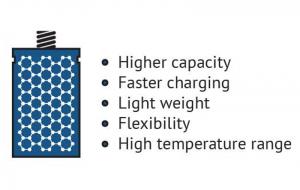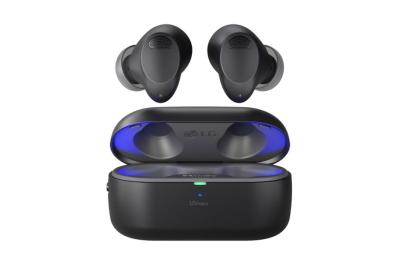Graphene is a one-atom-thick sheet of carbon atoms arranged in a honeycomb-like pattern. Graphene is considered to be the world's thinnest, strongest and most conductive material - of both electricity and heat. All of these properties are exciting researchers and businesses around the world - as graphene has the potential to revolutionize entire industries - in the fields of electricity, conductivity, energy generation, batteries, sensors and more.
Mechanical strength
Graphene is the world's strongest material, and can be used to enhance the strength of other materials. Dozens of researchers have demonstrated that adding even a trace amount of graphene to plastics, metals or other materials can make these materials much stronger - or lighter (as you can use a smaller amount of material to achieve the same strength).

Such graphene-enhanced composite materials can find uses in aerospace, building materials, mobile devices, and many other applications.
Thermal applications
Graphene is the most heat conductive found to date. As graphene is also strong and light, it means that it is a great material for making heat-spreading solutions, such as heat sinks or heat dissipation films. This could be useful in both microelectronics (for example to make LED lighting more efficient and longer lasting) and also in larger applications - for example thermal foils for mobile devices. Huawei's latest smartphones, for example, have adopted graphene-based thermal films.

Energy storage
Since graphene is the world's thinnest material, it also extremely high surface-area to volume ratio. This makes graphene a very promising material for use in batteries and supercapacitors. Graphene may enable batteries and supercapacitors (and even fuel-cells) that can store more energy - and charge faster, too.
 The advantages of graphene batteries
The advantages of graphene batteries
Coatings ,sensors, electronics and more
Graphene has a lot of promise for additional applications: anti-corrosion coatings and paints, efficient and precise sensors, faster and efficient electronics, flexible displays, efficient solar panels, faster DNA sequencing, drug delivery, and more.
Graphene is such a great and basic building block that it seems that any industry can benefit from this new material. Time will tell where graphene will indeed make an impact - or whether other new materials will be more suitable.
The latest Graphene Application news:
LG Electronics launches new TONE Free Wireless Earbuds with 'pure graphene'
LG Electronics (LG) has launched its latest TONE Free T90S model to the global market, designed to offer improved sound for a heightened listening experience. LG stated that its new T90S earbuds are 'enhanced by pure graphene'.
Delivering an enriched audio experience with improved accuracy and clarity, the newest T90S earbuds use pure graphene for drivers, a departure from the conventional use of coated graphene. The use of pure graphene in LG’s latest earbuds reportedly reduces vibrations and allows users to revel in well-balanced and precise sound with powerful bass and enhanced mid- and high-range frequencies. The T90S earbuds are designed to take full advantage of graphene’s lightweight nature, ensuring a cozy fit that ensures comfort for prolonged listening.
Levidian suggests graphene as solution to EV tire wear pollution
Levidian has suggested to use graphene as a way to address the environmental impact of tire wear in electric vehicles, as early-stage research it conducted showcases promising results in leveraging high-quality graphene to mitigate environmental concerns linked to tire wear in EVs.
The heavier weight and greater torque of EVs has been shown to accelerate tire degradation, leading to increased rubber particulates that contaminate the environment. The widespread adoption of silica-filled compounds in tire treads, aimed at improving abrasion properties, can exacerbate the issue by causing faster migration of toxic anti-ozonant additives, particularly 6PPD.
Researchers detect current whirlpools in graphene at room temperature
Researchers from ETH Zurich in Switzerland and National Institute for Materials Science in Japan have used a nanoscale scanning magnetometer to image a distinctive hydrodynamic transport pattern—stationary current vortices—in a monolayer graphene device at room temperature.
By measuring devices with increasing characteristic size, the team observed the disappearance of the current vortex and thus verified a prediction of the hydrodynamic model. they further observed that vortex flow is present for both hole- and electron-dominated transport regimes but disappears in the ambipolar regime.
Researchers report quantum anomalous Hall effect in rhombohedral graphene
Researchers at the Massachusetts Institute of Technology (MIT), University of Texas at Dallas and Japan's National Institute for Materials Science have reported the quantum anomalous Hall effect (QAHE), a topological phenomenon that features quantized Hall resistance at zero magnetic field, in a rhombohedral pentalayer graphene-monolayer tungsten disulfide (WS2) heterostructure.
This achievement can also be described as a 'five-lane superhighway' for electrons, that could allow ultra-efficient electronics and more. The team explained that its discovery could have direct implications for low-power electronic devices because no energy is lost during the propagation of electrons, which is not the case in regular materials where the electrons are scattered.
Finnlines adopts GIT Coatings' graphene-based hard foul release hull coating across its fleet
Finnlines, a leading shipping operator of freight and passenger services, has partnered with GIT Coatings to accelerate its decarbonization efforts by adopting XGIT-FUEL, an innovative graphene-based hard foul release hull coating, across its ro-ro and ro-pax fleets.
Starting with their first vessel in 2022, Finnlines has already applied this high-performance hull coating to four vessels as part of a recently signed fleet agreement, reducing fuel consumption and emissions by around 7% compared to previously used coating.
Researchers propose "Universal Murray's Law" for synthetic materials
Researchers from the University of Cambridge, Tokyo Institute of Technology, University of Warwick and University of Namur have proposed a new materials theory based on "Murray's Law," applicable to a wide range of hierarchical structures, shapes and generalized transfer processes.
The scientists experimentally demonstrated optimal flow of various fluids in hierarchically planar and tubular graphene aerogel structures to validate the proposed law. By adjusting the macroscopic pores in such aerogel-based gas sensors, they also showed a significantly improved sensor response dynamics.
Researchers develop graphene oxide spray coating for antiviral protection of face masks
Researchers at Spain's IMDEA Materials Institute, Rey Juan Carlos University and Valladolid University have developed a new spray coating to improve the antiviral efficacy of personal protective equipment, notably face masks.
The team's system is based on nanoplatelets of graphene oxide (GO) spray coated via a simple one-step procedure over a poly(lactic acid) textile fabric, allowing a homogeneous coating. The incorporation of GO does not affect the textile structure nor its air permeability, while it increases its water contact angle, potentially preventing droplet trespassing.
AlterBiota raises USD$2.9 million for biographene concrete additive
Canada-based AlterBiota has received CAD$4 million (over USD$2,925,000) in seed funding to increase hiring and upgrade its commercial-scale facility to make a concrete additive based on its biographene material.
AlterBiota's CEO, Mark Masotti, is a chemical engineer who researched graphene’s ability to decarbonize concrete while on parental leave in 2019. Fascinated by its application, he explored the idea in his basement lab and applied for a provisional patent, then developed the idea into a company. Having conducted tests on its biographene and establishing a pilot plant, Masotti plans to go further in more than doubling his company's staff and building a scale-up plant.
Tachmed partners with St George’s, University of London, to advance graphene-based health diagnostic platform
Tachmed, a UK-based developer of at-home digital healthcare solutions, has teamed up with experts in infection control at St George’s, University of London, to help accelerate the development of a new diagnostic platform for a range of health conditions, using graphene biosensor technology.
During the four-month collaboration, funded by an Innovate UK Accelerated Knowledge Transfer grant, Dr. Henry Staines, senior lecturer in global health at the Institute for Infection & Immunity at St George’s, will provide critical knowledge exchange. This is expected to boost development of the technology by optimizing Tachmed’s biosensor, which is required to confirm if a pathogen is present or not within a patient sample.
HydroGraph to supply graphene to Volfpack Energy for solar power battery storage
HydroGraph Clean Power has announced that its flagship graphene product, FGA-1, has been chosen by Volfpack Energy, a hardware company focused on using supercapacitor technology to increase the adoption of renewable energy across Asia.
Its flagship product, fractal graphene, FGA-1, was chosen by Volfpack to be the base material of the supercapacitor design after Volfpack’s engineers determined that it outperformed materials traditionally used in supercapacitors, such as activated carbon, by 4x.
Pagination
- Page 1
- Next page
